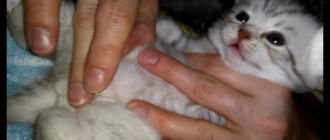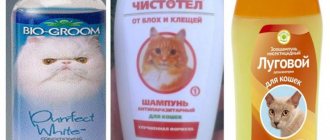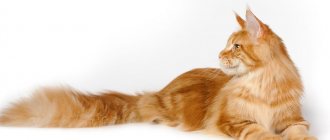It is easier to accustom a small kitten to water procedures than an adult. Owners of a sexually mature animal are faced with the following problem: how to bathe a cat if it is afraid of water.
Experienced breeders advise gradually accustoming your pet to bathing, not forgetting about little tricks.
You should act carefully, without forcing your pet, without showing aggression.
Patience and a friendly attitude will help you find contact even with an adult wayward animal.
Causes of fear
Fear and aversion to water is a natural cat reaction.
Your pet can and should be bathed. The cause of fear is caused by many factors. This may be an unusual environment, too bright light, noise and shouting of people.
Situation
In the bathroom, the animal's movements are constrained, sounds seem sharp, and the sound of water is frightening. Often the owner shouts at the cat if it behaves too aggressively.
The animal does not like that in the bathroom it cannot gain stability, clinging to its claws, while being forcibly held down.
Reaction to shower and hot water
Water flows out of the shower spray noisily and in large streams, which greatly frightens your pet. The animal perceives the hissing pressure of water as a living aggressive creature.
Fluid temperature is not always adjusted (too cold or too hot). When swimming, these factors should be taken into account first.
What not to do when bathing an animal
Common mistakes that cat owners make when carrying out hygiene procedures for them:
- You should not open the tap and immerse the cat in water - a strong flow will scare him;
- you should not turn on the shower and try to wash off the foam from the animal with a stream of water;
- a frightened animal should not plug its ears with cotton wool - this will only cause it irritation;
- It is not recommended to bathe a cat with dog products, shampoos for other animals, and especially with dishwashing detergent;
- Shampoo is often poured from a jar directly onto the wool - this is wrong, especially if the skin is dry;
- You shouldn’t try to calm the cat down by feeding him sedatives - they do more harm, and there are side effects.
© shutterstock
Tips for the owner: how to wash a cat
To prevent your cat from experiencing stress during bathing, it should be accustomed to the procedure from an early age. Kittens begin to be washed after the complete replacement of milk teeth. At first, they simply dip their paws in water.
How to bathe an adult animal:
- Remove foreign objects from the bathroom, especially those that rattle a lot (buckets, basins, bowls).
- All windows are closed to avoid drafts.
In the bathroom, a towel and pet shampoo are placed at arm's length so that they can be quickly grabbed.- The water temperature and pressure in the mixer are adjusted in advance so as not to frighten the animal during the bathing process.
- The door to the bathroom is closed, sudden sounds and movements are avoided.
- Select a suitable water temperature in the mixer at + 35 ° C, fill the bath one third with liquid.
- The cat is taken by the withers and placed in a container. Wash the paws and body with water (it is important that the liquid does not get into the eyes, nose, ears).
- A small amount of shampoo is squeezed into the palm of your hand, rubbed, applied to the pet’s fur, and foamed. While bathing, the cat is calmed down, talked to calmly and affectionately.
- The foam is washed off with a shower hose, the pressure is set to low so as not to frighten the pet.
If necessary, the entire procedure is repeated twice.
The shampoo is washed off thoroughly: cats lick themselves, and the remains of the detergent can get on the tongue and into the esophagus, harming their health.
Then the pet is dried with a towel; you can dry it with a hairdryer if the cat is not afraid of its noise.
What will you need to bathe your cat?
If you have already decided to give your cat a bath, but she is afraid of water and scratches, it is important first of all to stock up on everything you need and be well prepared:
- Shampoo. Pay special attention to shampoo. You need to choose animal shampoo for bathing, and not use your own. You can use regular cat degreasing shampoo. It will provide basic coat care. It is also advisable to use a special cleansing paste: it is applied to the most problematic areas before washing. Some people also choose texturizer shampoos, which add shine and volume to the coat and make combing easier. Long-haired cats need such formulations.
- Latch. A very useful modern invention will allow you to limit your cat’s physical activity in the bathroom. The accessory is a special collar with a cord that has a suction cup at the end. It is attached to the bathtub so that the animal does not escape from the bathtub. It will be able to move, but it will no longer be able to jump out of the room. An excellent solution for anyone who doesn’t want to chase a scared, wet cat throughout the apartment.
- Massage mitten. You can wash the animal by hand, but this is inconvenient and ineffective. It is much better to take a special massage mitten. With its help, it is much easier to distribute the shampoo throughout the coat, rub it in thoroughly, and then rinse well along with the dirt.
- Towels. After bathing the cat, you need to dry it well so that it does not leave wet marks behind and does not catch a cold. It is advisable to use at least two large towels. The first will become the base - the main moisture will be absorbed into it. But with the help of a second towel you can dry the animal’s coat more thoroughly. Proper drying will quickly restore the cat’s normal thermoregulation.
Preparation for water procedures
Prepare for washing the cat in advance.
Everything necessary for the procedure is laid out nearby, and unnecessary items are removed. Protect your pet's ears with large balls of cotton wool. They should be large enough to cover the ear canal, and after the procedure it will not be difficult to remove them.
To clean the fur, use special shampoos for animals. Detergents for humans are not suitable for them: such products have a different acidity level (PH) and cause irritation on the skin of pets.
Nail trimming
To protect yourself and the animal if it scratches, the cat’s claws are cut before taking a bath. Frightened cats often try to get out of the bathtub by climbing up their owner's arms.
An animal without claws will cause fewer injuries.
Use of special devices
Pet stores sell mesh bags for bathing cats.
The animal is placed in this bag, the headband is fastened around the pet's neck. The device will help pacify your pet: he will not scratch or try to get out of the water.
Large mesh cells do not prevent the penetration of water and detergents into the wool, and bathing will take place without problems. The owner will have both hands free, he can easily soap the pet and rinse off the detergent.
Bath equipment
It is important to prepare the bathroom before bathing your cat at home. A soft mat is placed at the bottom of the bath, which fits tightly to the surface.
Place 2 buckets with a volume of up to 15 liters nearby, wide but shallow, and fill them with warm water. Metal containers create a lot of noise, so it is better to choose plastic. Several caps of concentrated pet detergent are dissolved in one.
It is better not to use basins: they take up a lot of space.
Detergents are placed on the side of the bathroom so that they are easy to reach.
The shower is turned on at the lowest power so that the noise of the water does not frighten the pet. Place old towels or clean sheets nearby, which absorb liquid well after bathing.
Assistant
If a cat bites or runs away from the bath, and there is no special device to restrain it, the help of another family member is needed.
It is easier to bathe a cat without consequences together: the assistant will hold the pet, and the owner will wash the animal without difficulty.
Optimal age for first bathing
Cats are excellent swimmers. Some varieties, such as the Turkish Van, love water and are willing to swim every day, this is due to the special structure of their coat. And the dislike of washing in most breeds is due to poor thermoregulation of these animals.
A wet cat, in addition to experiencing unpleasant sensations from the cold, is an easy prey for a hypothetical enemy, since it is helpless and its smell at this moment is too distinct. Therefore, the animal is in a hurry to shake the water off its fur and immediately dry itself with its rough tongue.
If the pet was purchased from a nursery, then there is no need to rush into the first bath. It is necessary to give the kitten time to get comfortable in the new home, because moving is a huge stress for the baby and it is not advisable to aggravate it.
But a kitten picked up on the street must not only be washed, but also treated for external parasites and dewormed if its health condition allows this.
Very small kittens, up to three months old, can simply be wiped with a wet sponge and combed.
Pedigree kittens, especially semi- or long-haired breeds, begin to be accustomed to water procedures from this age. This is especially true for Persian, Angora, and British cats.
If the animal is going to be exhibited, then it will have to be washed before each show, so it is important that this procedure becomes familiar and loved for the pet.
Algorithm for bathing a pet
All actions are performed without haste:
- The animal is picked up, stroked, calmed, and taken to the bathroom. There, the hind legs are fixed with the right hand, holding the animal under the abdomen. With your right hand, grab the front paws, picking up the cat under the ribs.
As soon as the animal is securely fixed, it is carefully immersed in a basin of water, the hind legs are released so that the pet rests them on the bottom of the container.- The front paws are held with the left hand, and the cat is washed with the right. The animal must be immersed in water up to its neck.
- The soap solution is applied to the entire coat (except the head) and the integument is washed with light massaging movements. Areas where vegetation is dense are especially good for cleaning.
- It is not recommended for an overly emotional or fearful pet to wash its hair. This part of the body always remains clean. The muzzle is wiped with a damp towel.
- As soon as bathing in a bucket of soapy water is completed, the cat is transferred to a container with clean liquid. The animal's fur is thoroughly washed to remove any remaining foam.
Water from the shower will help to completely clean the cat of soap.
You can empty the first bucket of dirty water, rinse it, and fill it with clean water. Then the animal is once again transplanted into the container, and its fur is washed well.
After bathing, it is important to thoroughly dry your pet's coat with a clean cloth or hairdryer that absorbs moisture.
The first option is preferable: the noise of the unit is additional stress for the cat.
The owner makes sure that there are no drafts in the house during drying: a wet pet can easily catch a cold. Kittens and older animals with weakened immune systems are especially protected.
A mustachioed pet that has passed all the tests with dignity is given a treat to relieve stress after contact with water.
If the cat stops licking itself
In this case, very quickly her appearance becomes unkempt and unkempt. Giving up a natural habit always indicates serious problems and should cause concern to the owner.
Oral diseases
Often the reason for refusing to wash your face is diseases of the gums and oral cavity. For example, gingitis, the initial stage of periodontal disease.
An inflamed, red area appears around one or more teeth, and over time it becomes covered with ulcers and sores. Any movement of the tongue causes severe pain to the animal and, along with other signs such as putrid odor from the mouth, refusal to wash also indicates this unpleasant disease.
Arthritis of the joints
If a cat develops arthritis of the joints, any movement causes him pain. He washes himself less often and less effectively. If the front paw is affected, it is difficult for the pet to wash its face. But if the back hurts, then usually nothing prevents you from reaching the sore spot, and the animal will lick it especially long and carefully, trying to reduce the discomfort.
Excess weight
Obesity is another problem in modern pets, especially after spaying and neutering. If pets are not switched to proper nutrition after surgery, excess weight will inevitably appear in a few months.
In addition to changes in appearance and gait, insufficient washing is another symptom of this pathology. It is caused by difficulty in mobility and the clumsiness of overweight animals.
Stressful conditions
Sometimes a cat stops licking itself due to severe stress. This is, for example, how a young animal behaves when it changes its owner and place of residence. It has been noticed that a pet sometimes does not drink, eat, go to the toilet or wash itself for several days.
Usually, the patience and affection of a person helps the kitten cope with its depressed state and return to normal life.
Sometimes, out of fear and stress, a cat, on the contrary, begins to wash itself incessantly. This is also a reason to seek veterinary help. Your pet will most likely be prescribed sedatives.
Systemic and infectious diseases
If the cat has stopped licking itself, its fur looks greasy, dirty, this is accompanied by apathy and lethargy, loss of interest in food and games, you should immediately consult a veterinarian.
All severe infectious diseases and chronic pathologies fit this set of primary symptoms, and it is important to quickly establish a diagnosis and begin treatment.
Veterinarians note that in the presence of fleas, other external parasites, helminths, and allergic reactions, the pet, on the contrary, becomes overly active, even more irritable and constantly licks itself.
How to teach a cat to bathe
Each owner has his own secrets and approaches to his beloved pet. All of them can be combined into a list of simple recommendations that will reduce the innate fear of water in cats.
Advice from experienced breeders:
It is worth teaching your cat to take water treatments from an early age. From the age of 2 months, the kitten can be placed in a small basin and its paws can be gently washed. Growing up, a seasoned pet will not be afraid of water.- A few days before bathing, an adult animal is placed in an empty basin, having first filled it not with water, but with its favorite toys. At the same time, the animal is given a treat or catnip: the cat will not associate the bathroom and basin with danger.
- As soon as the animal gets used to the empty container, fill it a few centimeters with warm water and put toys in it. The cat is lured with interesting objects or treats, and invited to climb into the basin.
- If your pet is too nervous when taking water procedures, it is better not to keep him in the bathroom for a long time. The animal is lightly rinsed, and bathing is postponed to the next time. The procedure is repeated regularly, do not forget about it.
The pet is combed before washing - this makes washing the fur easier and faster. This removes tangles and dirt, and makes the bathing process easier.
If the cat, after all the tricks, is not used to swimming calmly, contact a groomer. A professional will be able to wash the animal quickly and without consequences, making the task easier for the owner.
How to properly bathe a shy cat when he scratches?
Many people note that it can be even easier to bathe a small kitten than an adult animal. Kittens are not so timid; they quickly come to terms with bathing as if it were inevitable, even if they don’t like the process. In addition, it is easier to handle babies by holding them in the desired position.
A domestic cat, for example, can suddenly show powerful resistance: it will scream, struggle and scratch, splashing a lot of water around.
But there are some useful tips that will help you cope with bathing:
- Get your pet used to bathing. Let the whole process turn into a kind of training. For example, you can treat your cat with his favorite treat after a bath.
- Be kind , speak gently, and never yell at the animal.
- Keep in mind that bathing can be stressful for your cat. Try to distract him with toys and conversation.
- Be persistent , but don't frighten your pet even more.
- The optimal solution is to bathe the cat together if it resists strongly. One person will be able to secure the animal well (you can only hold it by the paws and withers, you cannot squeeze it across the body), and the second will do the washing.
The main thing is to take into account all the nuances, do not offend or frighten the cat, do not provoke aggression from him.
How to dry
After bathing, the pet is dried with a terry towel and wrapped in a soft cloth. You should not rub the fur vigorously - it will become very tangled.
Then the kitten is released. He begins to actively lick himself and dries his coat on his own. The rough tongue combs the hairs and evenly distributes protective lubricant over them.
If your baby trembles for more than 5 minutes after bathing, you should use a hairdryer. The same applies to long-haired breeds. However, the baby must first be introduced to this device, otherwise he will be scared. The air flow should be warm, but not hot. During the drying process, the fur is combed in the direction of hair growth.
Important. For 12 hours, the kitten should be in a warm room without drafts and not go outside.
If you bathe a kitten correctly, it will not be afraid of water. It is important to teach your baby hygiene from childhood and use suitable detergents - then the procedure will not cause much trouble.
Features of washing cats of different breeds
Some breeds have their own characteristics for water procedures. Individuals with short hair bathe less often than their long-haired counterparts. The Sphynx breed has many different rumors about washing; they supposedly need to be bathed every week.
In fact, it is much better to wipe them regularly with a damp cloth or cloth. You should only bathe if you are heavily soiled. The Burmese cat has a very beautiful shiny coat, the appearance of which must be maintained in this condition. If you do not carry out care procedures, the cover may become similar to hedgehog spines. Such pets need to be regularly wiped with chamois and wet wipes. Such manipulations will give the hair a characteristic beautiful shine.
Brushing is done once a week. To do this, you can use a special glove, brush, and antistatic agent.
Coons and Britons have particularly sensitive skin. For them, you should carefully select veterinary shampoos that are suitable for the animal’s coat type. If you use low-quality cosmetics, the animal’s skin may begin to itch, dandruff or other negative consequences may appear.
How often to wash
Cats' natural love for cleanliness makes bathing an auxiliary, rather than a primary hygiene procedure. On the contrary, too frequent washing degrades the quality of the fur.
The frequency of washing kittens depends on the breed, coat length, and health status. As a rule, cats are bathed 6 times a year. If the animal does not leave the apartment, bath days are held once a quarter or six months.
Often you can only wash kittens of hairless breeds. They get dirty faster, so they get water treatments about once a month. Show cats are given unscheduled baths before shows.
For your information. If a cat goes outside, be sure to wash its paws after each walk.
How to wash a kitten
Kittens are bathed using gentle products. Shampoos are not suitable for people - they are too aggressive.
Manufacturers produce cosmetics for a specific skin type:
- dry;
- fat;
- normal;
- damaged.
The most common are liquid shampoos and conditioners. They can contain both regular cleaning agents and special components. For example, to kill fleas, ticks and other parasites.
There are other types of cat shampoos:
- Dry shampoo is in powder form. Contains absorbent components: they remove excess sebum and dead skin flakes. However, it is not able to cope with heavy pollution. Used as an express remedy for show pets or kittens that are afraid of water. Suitable for use in winter as it avoids hypothermia.
- Spray shampoo - works almost the same as dry shampoo. Moisturizes and conditions the coat, helps get rid of tangles. A good option for partial bathing, when you just need to refresh your coat.
Some owners use a mixture of baby powder, cornstarch or baking soda as dry shampoo. However, this is quite risky. By absorbing moisture, starch releases gluten. If water gets on the skin, it will swell and stick to the fur.
It will most likely not be possible to comb it out - the animal will still have to be washed. The soda must be carefully removed, otherwise the cat will be poisoned by eating it while licking it.
Important. It is better to bathe animals using industrial dry shampoos. For example, brands Trixie Trocken and Mr. Gee.
When choosing a detergent, you need to take the following points into account:
- Short-haired, long-haired and hairless kittens are bathed with shampoos from separate lines.
- You should buy shampoos designed specifically for cats, or at least for cats and dogs. However, some show cosmetics are only made for dogs. It is used in extreme cases.
- Concentrated shampoos are more expensive, but are more economical. Before use, they must be diluted with water according to the instructions.
The most popular cosmetics that can be used to bathe a kitten are presented in the table.
| Effect | Name |
| Against parasites | “Disinfectant” (Bioflor company); |
| "Lugovoy" (Agrovetzaschita); | |
| “Tar” (Clandestine); | |
| "Doctor ZOO" | |
| Medicinal | "Doctor" (Goodman); |
| "BioVax for kittens"; | |
| Beaphar Shampoo Anti Dandruff | |
| For damaged skin and coat | Iv San Bernard Zeolithe |
| Strengthening and restructuring the coat | YuuP! Professional Restructuring & Strengthening; |
| Tropiclean Lime/Coconut | |
| To regulate shedding and against tangles | FURminator spray; |
| Perfect Coat Shed Control & Hairball (8 in 1); | |
| Phytoelite (Veda) | |
| Caregiver | Iv San Bernard Atami (antistatic); |
| “Gentle”, “Marine” (Agrovetzaschita); | |
| “Velvet” (CrystalLine); | |
| Artero 4Cats | |
| To add volume | Anju Beaute Texture Volume |
Important. The kitten may be hypersensitive to some component of the detergent. Therefore, after bathing you need to monitor the baby’s condition. If an allergy occurs, you should contact your veterinarian.
Veterinarian advice
Veterinarians advise using a retainer while bathing. This is a suction cup with an attached collar and cord. The retainer ensures the safety of the animal and its owner. The device eliminates the need to call an assistant.
When swimming, you need to control the temperature in the room. Sudden changes should be avoided. It should be warm in the bathroom and outside. You should not take your pet into a cold room after bathing.
It is advisable to avoid hygiene procedures. If you want to help your cat cool down in the summer, use a spray bottle and lightly dampen your cat's fur. You should not bathe your pet, because... The water will make it more difficult for him to regulate his temperature. Fans are also a bad option. A draft can cause your pet to catch a cold.
In winter, if your pet's coat has become oily, you can use dry shampoo. It helps remove excess sebum without moisturizing. This method is also suitable for nervous and aggressive animals. If bathing a cat causes severe stress, but it is impossible to avoid it, it is allowed to use mild homeopathic sedatives.











